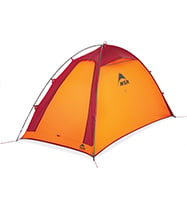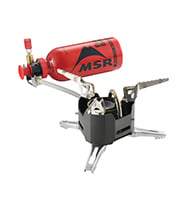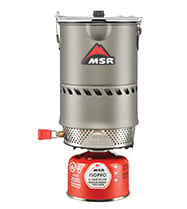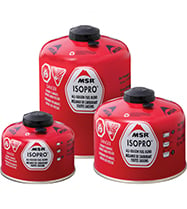Trip Report: Climbing in Pakistan’s Karakoram Range
Travel Chaos
Our Pakistan expedition started out with high stress levels, to say the least. Our bags were painstakingly packed—gear organized, packed, organized again, double-checked, and repacked. As we celebrated our last night in the US with some friends in Denver, Colorado before catching our morning flight, Allen received a terrible email—our flight was canceled!
When we had started planning our expeditions to Pakistan’s Karakoram range, we figured it’d be a long shot in light of ever-changing COVID restrictions and complications. We kept a hawk-eye on climbers that we saw were getting into Pakistan and bombarded them with questions. Countless hours were spent trying to communicate with officials in Pakistan and researching any info we could find online. Months prior we had booked our flights and now tickets were thousands of dollars apiece, salt in the wounds of our ever-accumulating expedition costs, not to mention the nearest availability was three weeks out.
“Screw it”, I said. “We’re going to Peru”. Both of us spent time in the Peruvian Andes and it had already been decided that in the event of our Karakoram plans going up in smoke, we would beeline it to Peru instead. We were just about to book our tickets to South America when we decided we’d spend one more hour attempting to figure out if we could still get into Pakistan. Long story short, we booked a one-way to Dubai, and then a separate flight on a slightly questionable Pakistani airline from there. If our Pakistani airline flight got canceled once we were in Dubai, we would fly straight to Peru. It was a solid battle plan, despite leaving us wincing at the consequences of buying next-day international flights.
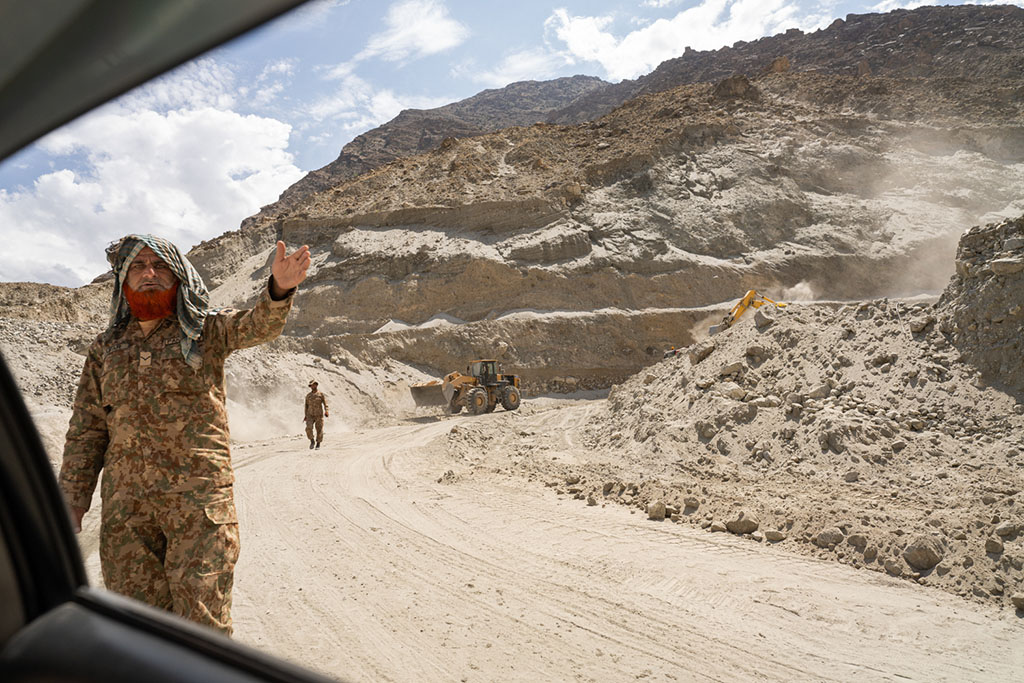
Our strategy worked, and after four days of traveling, we stepped foot on Pakistani soil. From Islamabad, we hopped in a car and spent the next two days driving to Skardu on the infamous and stunning Karakoram Highway. Our piles of duffel bags and gear were shipped on a bus, and I muttered a prayer that it would all arrive. My prayers were granted, but once everything arrived we faced a dilemma. The airport had taken the fuel pump for our MSR XGK stove, the only stove we had brought for the trip. We desperately needed to find a new stove option and were getting worried. By some stroke of luck, we located a gear shop that buys and sells used gear from climbers. We found an MSR Reactor stove that had likely been through a decade of expeditions in the Karakoram and had been used on K2. It fired up perfectly; case closed!
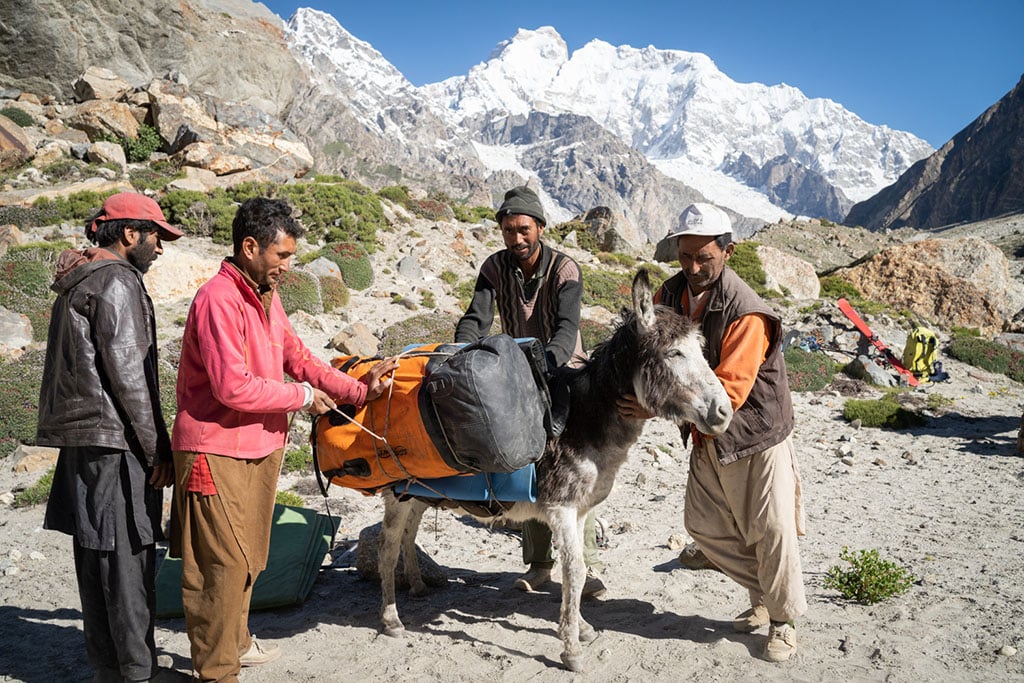
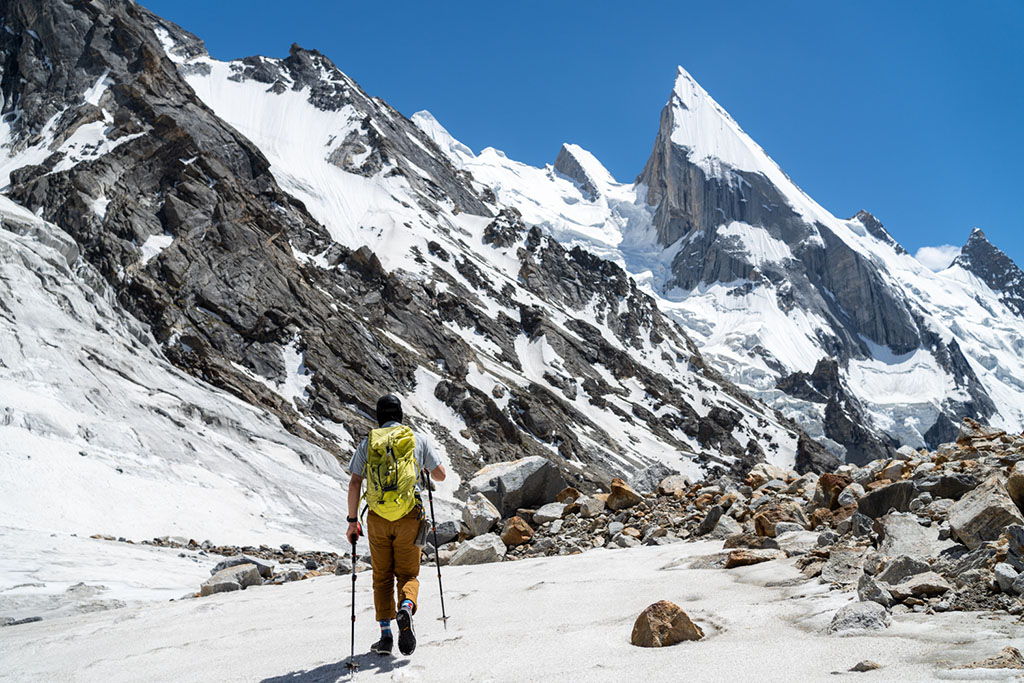
Laila Peak
Our spirits were high and I couldn’t wait to get back in the alpine. We loaded into an ancient-looking Toyota Landcruiser (unanimously pronounced “Jeep” in Pakistan) and spent another day driving to the Hushe Valley. Laila Peak, an iconic pyramid-shaped mountain that rises to 6096 meters, was our first objective and we intended to ski from the summit or the highest point possible. The porters from the village arrived and gear was distributed and packed in a controlled frenzy, ready to leave at the crack of dawn. Allen and I were already exhausted, not to mention jet-lagged, from the constant travel over the last seven days, and he began to feel a little queasy from a lunch stop at a trout farm that day. Within a few hours, he was overcome by the most violent bout of food poisoning I have ever witnessed in a human being. It continued throughout the night, and at one point he literally collapsed and face-planted while vomiting. I don’t know what’s worse, watching your friend faint into a pile of his own puke or knowing that you both ate the same thing and it’s a countdown until you’re in the same boat.
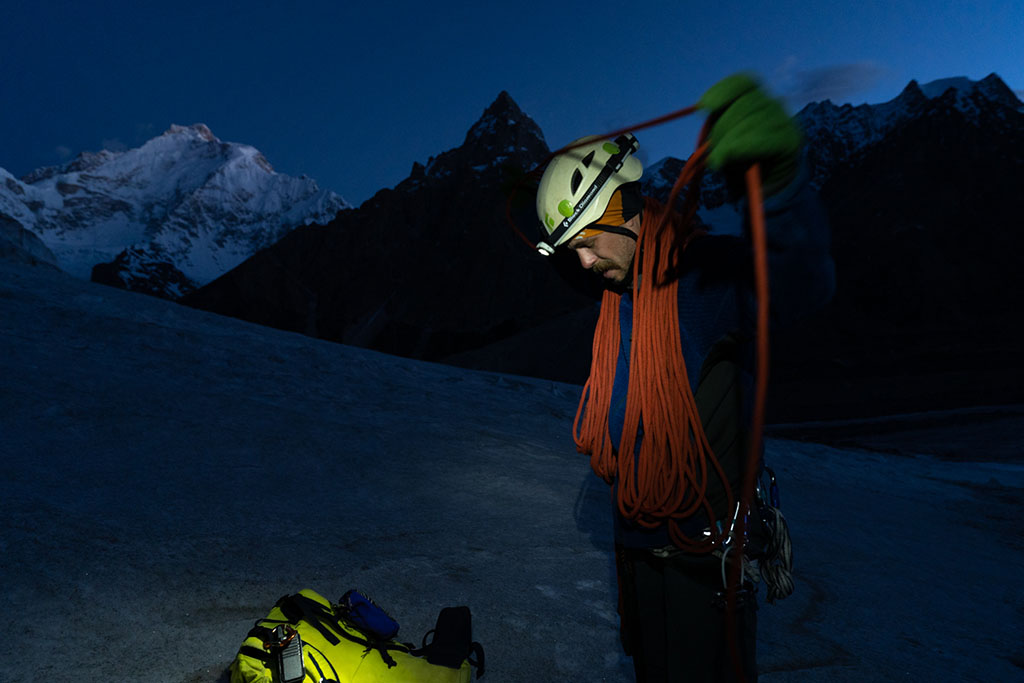
Sure enough, the effects of food poisoning started hitting me but fortunately without quite as much intensity. The next morning Allen felt half-decent despite his food-poisoning-from-hell event. The porters shouldered their loads and jetted off on the trail while Allen and I brought up the tail. I was struggling to put one foot in front of the other and frequently stopped to take code red emergency bathroom breaks. On the approach, we had a glorious view of 7821m Masherbrum, also known as K1 since it was the first mountain to be mapped out in the Karakoram. We eyed it with envy. Next year, perhaps.
After two days of trekking, we arrived at our basecamp in a beautiful grassy valley. Finally, after 10 days of rigorous travel, we could begin what we came here for. We paid and tipped our porters (not without an argument over what was an acceptable amount) and arranged to have them return in five days’ time. I was struggling to recover from the food poisoning and our cook’s local and spicy food (although tasty) didn’t help Allen’s nor my already weakened stomachs.
We spent two days moving loads to our high camp and surveying our route on the south face of Laila Peak. To our great disappointment, the face was completely out of condition for a ski descent, and a porter informed us that we were a month or two too late—information that was impossible to find via the internet. Unfortunately, we had to forego our initial plan to ski/splitboard the south face. As with any remote area that is seldom traveled, it is often impossible to gather local knowledge of a specific mountain or valley outside of having boots on the ground. For our Pakistan expedition, Allen and I had intentionally sought out mountains that were less of a technical climb and more of a committing ski-mountaineering objective. Because of that, I had only brought my splitboard-mountaineering boots that have no toe welt and are only able to accept semi-auto crampons. Immediately I regretted my decision to leave my climbing boots in Skardu, but I had done a fair bit of alpine climbing in the same set of boots and crampons so I figured they’d hold up. Allen’s ski boots of course took full auto crampons and handle the same if not better than climbing boots at times.
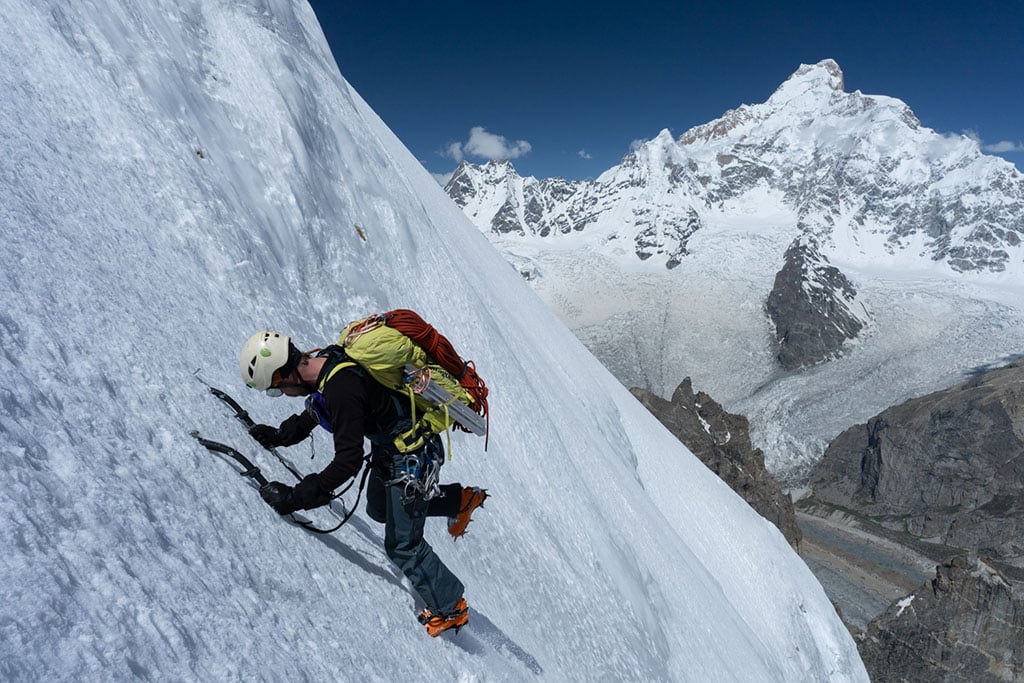
A 4 am alpine start fueled by a cup of Trader Joe’s instant coffee had us underway. In the wake of our Alaska climb we were both extremely fit and felt confident about the 5,000-foot push to the summit from our high camp. Alpenglow hit the top of Masherbrum, and the higher we climbed the more we were able to see the vast Karakoram Range around us. K2 stood 20 miles to the north, dwarfing everything nearby, every bit as majestic and intimidating as I imagined it would be. It’s always hard for me to digest such incredible power and beauty while simultaneously attempting to focus on the task and climb at hand.
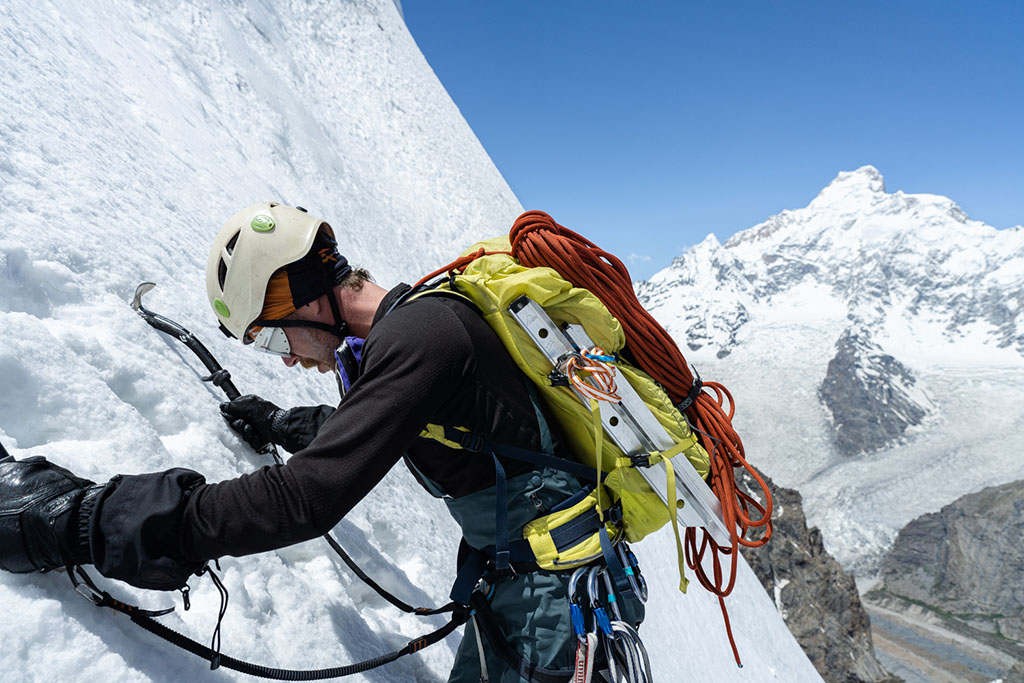
Allen and I took turns breaking trail and weaving our way underneath a maze of seracs. Things were moving along without incident, save for a break every 500 feet or less to gasp for air and give our burning calves a break. Around 3,000 feet up the south face, we started getting into 60-65-degree alpine ice due to the late-season conditions. Normally, this isn’t of concern and is usually excellent climbing, but a fairly worrisome problem began to arise. As I was front pointing up the section, my crampons began to quite literally fall off despite being as tight as they could be. I reached the top of the 100-foot section after essentially doing pull-ups ups for half an hour and was utterly exhausted, not to mention a little rattled by the fact that my gear was failing on high-consequence terrain. Allen and I always climb alpine style and we had opted to go unroped on this climb in order to climb as fast and light as possible. A fall would result in me bouncing 3,000 feet to the bottom. We had 2,000 feet left to climb, and the upper sections had looked icy from below. Pitching out these sections was not realistic as it would take too much time, so it didn’t take us long to decide to pull the plug and begin down climbing. While we could have most likely continued without incident, we were not comfortable with the safety margins that are important for us to abide by.
We were frustrated, but both share the same perspective when it comes to climbing; it’s not always about the summit, but about the collective climbing experience and the ethos behind the decisions we make on a mountain.
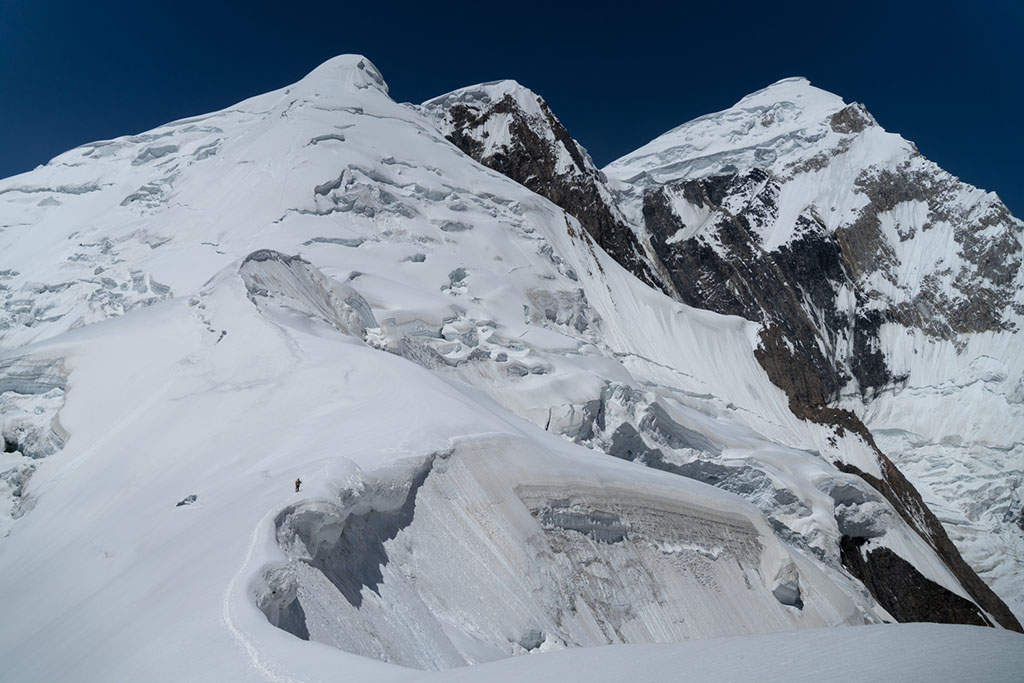
Spantik Peak
Once back in basecamp, getting back to Skardu was basically a reverse of the process to come in. We had two days of rest before we plunged into our next objective, Spantik Peak. Skardu is an ancient feeling city and the call to prayer that was belted out frequently throughout the day (not to mention early in the mornings and late at night) was eerily beautiful. We learned about the rapidly deteriorating situation next door in Afghanistan, and it was crazy and sad to think that so much violence and tragedy was happening only a day’s drive or a short plane flight away.
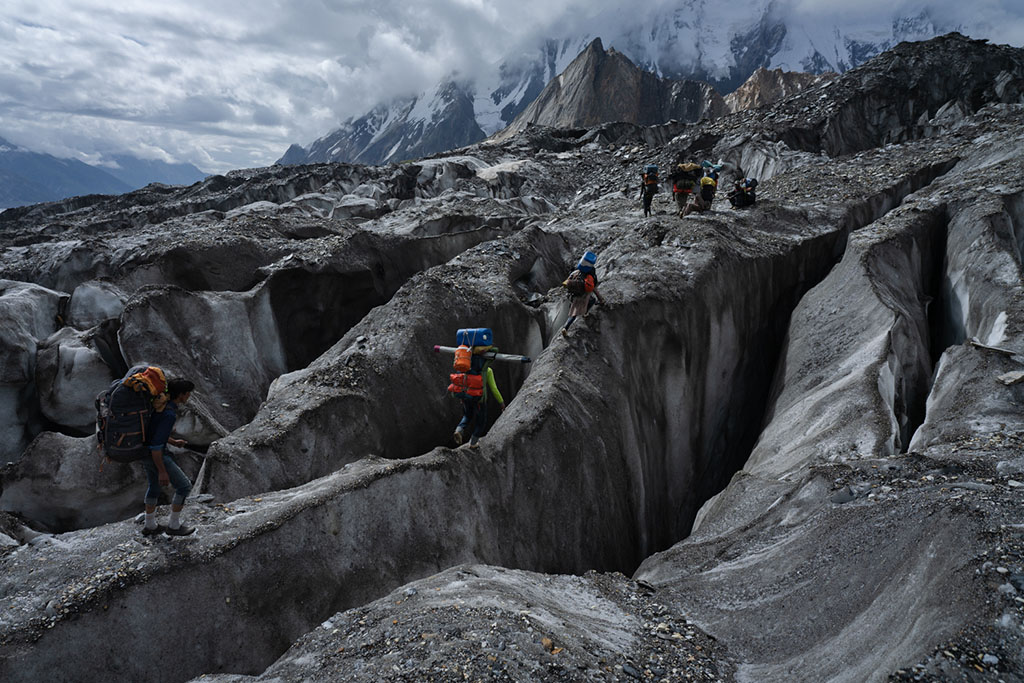
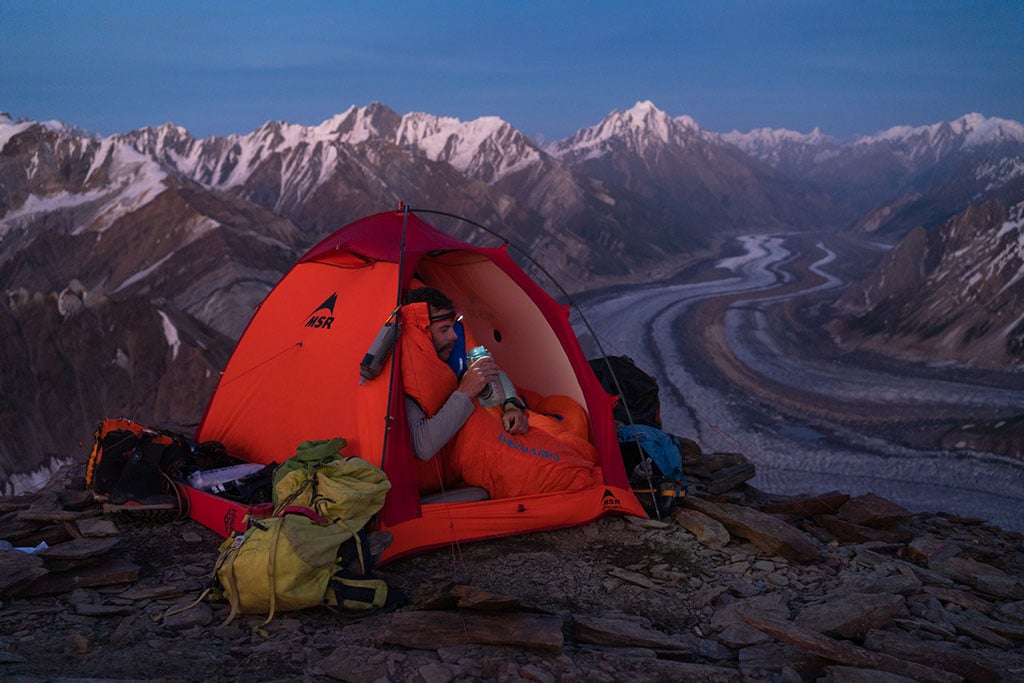
Again, the “Jeeps” were loaded and another day of bumpy riding brought us to the tiny village of Arandu. We gathered porters from the village and set off for our three-day trek the next morning. At 7,023 meters, Spantik is not necessarily as technical as Laila Peak but it is a good bit higher. We could barely sleep at the prospect of climbing and dropping in from 7,000 meters and thankfully weren’t plagued by debilitating food poisoning this time.
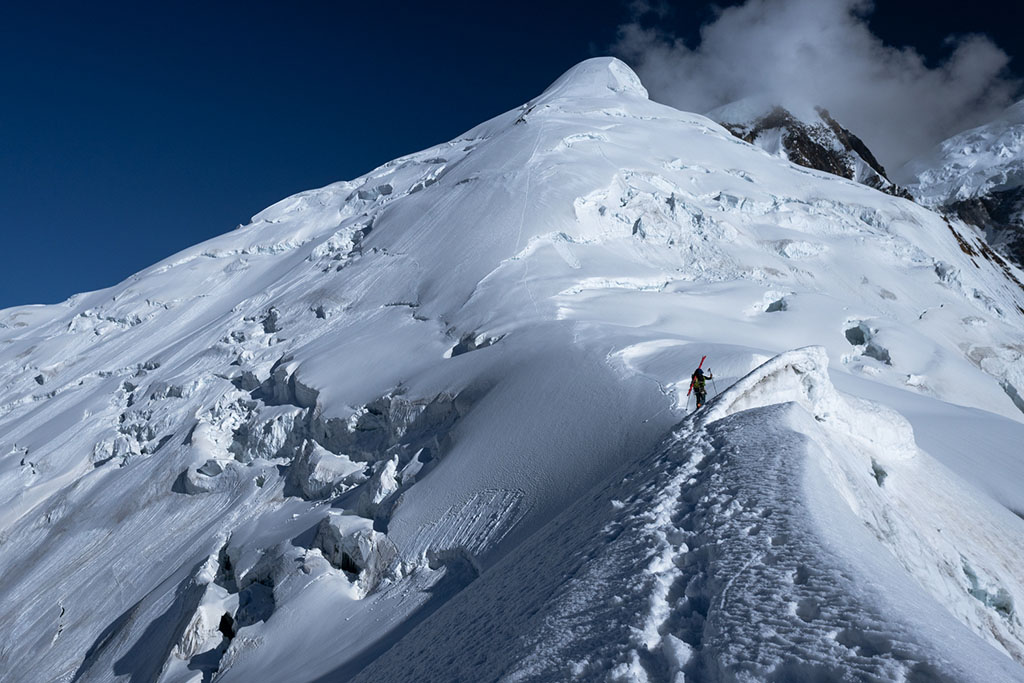
The goat path trail cut into the mountains and the last few miles wound through an enormous glacier. Basecamp was at 14,500 feet and the next day Allen and I kicked it into gear and began the slow and methodic process of climbing at high altitude. We carried loads up to Camp 1 at 16,300 feet, moving back down to basecamp to sleep. The day after we carried the rest of our gear up to C1, and then strapped our skis and splitboard on for a quick acclimatization lap before dark. The weather was perfect, the sun was setting, and we were surrounded by unclimbed 6,000- and 7,000-meter mountains. I’ll never forget ripping turns back to Camp 1, both of us laughing uncontrollably with joy. After all of the planning, training, invested finances, logistics and traveling around the world, we were finally doing what we came here for, even if it was just a few short turns.
On Day 3 we did a double carry to Camp 2 at about 18,200 feet. Spantik has a 7km-long ridgeline, and not all of it is climbing as much as a long-winded traverse along some knife-edge and overhanging sections. Both of us punched into multiple crevasses, albeit small ones, but nerve-wracking nonetheless. After carrying a heavy load up to Camp 2, going back down to Camp 1 and then back up with another load, we were feeling rather winded. The next day we opted to stay at Camp 2 and take a rest day as well as acclimatize.
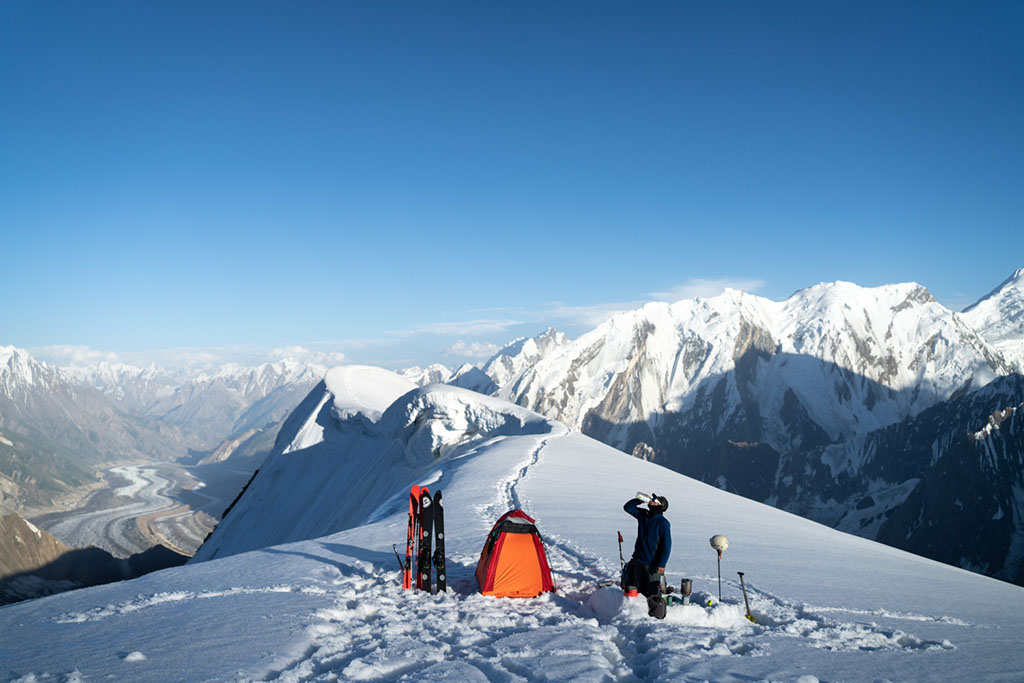
On Day 5 we packed as light as we could and began the trudge up to Camp 3. Our packs were around 45-50 pounds but felt much heavier as we broke trail in 45-degree waist-deep snow at 20,000 feet. It will all be worth it on the ski descent, we kept reminding each other. We stopped at 21,000 feet and pitched our ultralight Advance Pro 2 tent. We melted snow for dinner and the next day’s water supply, then hurriedly escaped the elements and burrowed into our cocoons, very happy for our -20-degree F sleeping bags.
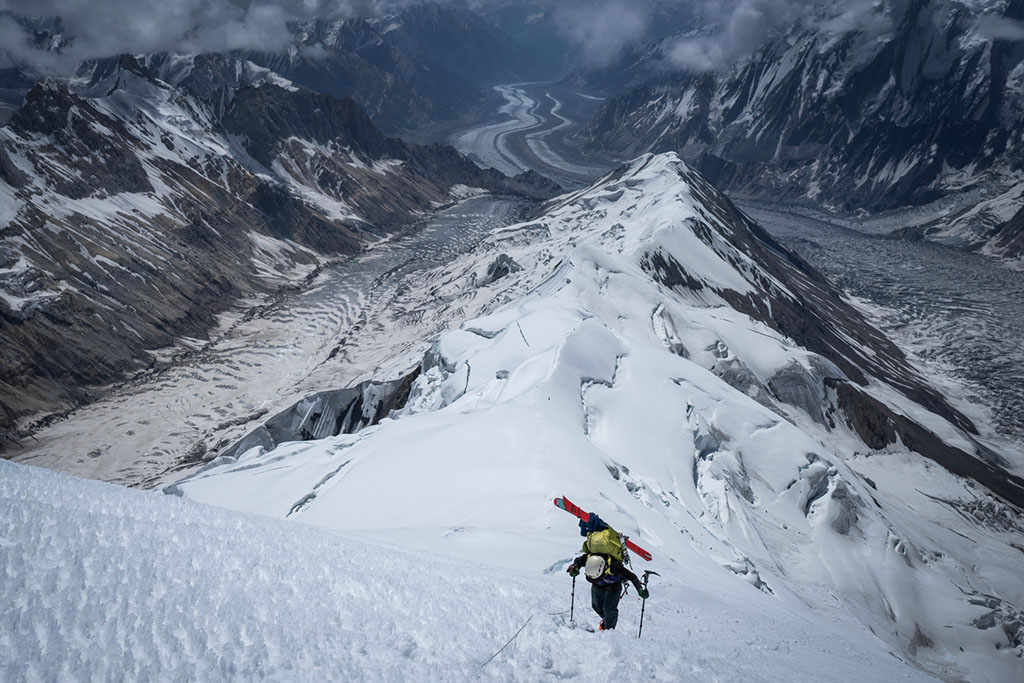
Summit Push
With a SAT device, we had texted friends and gotten reports of the weather forecast. It looked a little bleak, and the next morning confirmed our worries— the end of our high-pressure window. Plus, it was predicted to continually deteriorate with each coming day, and we knew that today was our last shot at a summit bid. Reluctant to don our frozen boots and gear up, we peeked our heads out of the tent flap and saw nothing but white. The wind was howling, occasionally blowing the clouds away for short moments, and we decided to make a push for it. We roped up and I set the skin track.
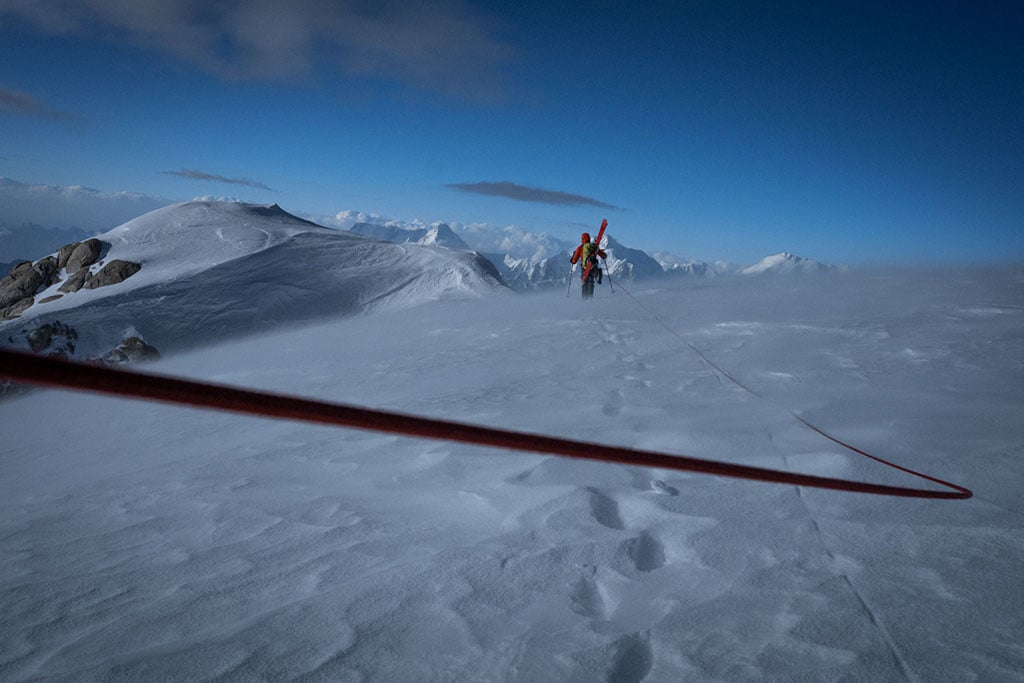
An hour in and we couldn’t even see each other on the end of the rope, much less navigate terrain just under 7,000 meters, so we headed back to our tent. In a situation like this, despite our striving to maintain a climbing philosophy that’s free of “summit fever”, it’s hard not to be disappointed. Getting shut down on both of our Pakistan objectives was not an easy pill to swallow. For me, the hardest part of high elevation climbing is the mental aspect. It’s the suspense of sitting in a tent and not knowing if you’ve come all this way just to turn around.
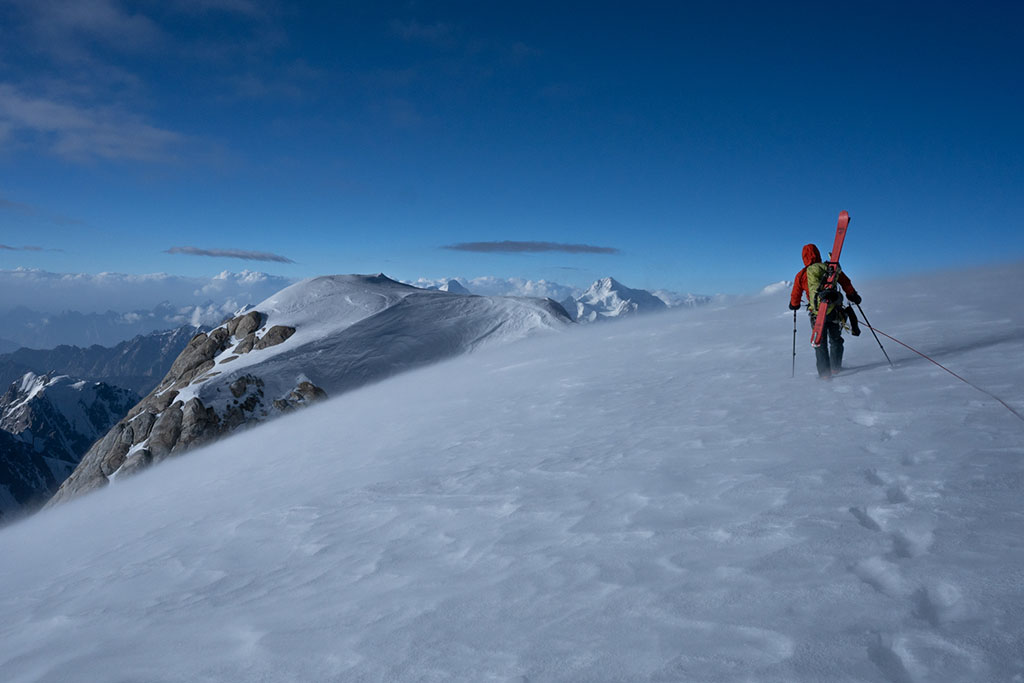
Hours went by, and we knew that if things didn’t clear up soon, our window would close. The wind was ripping even harder now, but we could make out the summit intermittently from camp. In a last-ditch effort, we roped up once again and continued moving higher, hoping the weather wouldn’t turn even worse than it already was. The final 2,000 feet from high camp was fairly straightforward but far from easy. Our progress moved to a crawl as we battled deep snow and 50 mph+ winds that made it difficult to breathe in the already thin air. I tried to remember the last time I had been this cold. I hate this shit, I thought to myself. I could be surfing in Mexico or something, but instead, I’m nearly getting blown off this mountain in the middle of nowhere. 22,000 feet… 22,500 feet… 22,600 feet… 22,700 feet. The last several hundred feet seemed to drag on for hours.
We reached the summit at 23,041 feet just before 6 pm, and could barely hear each other despite shouting at the top of our lungs. We forced ourselves to snap a couple of photos of us and our beloved Pirates of the Carabiner flag. It was a happy moment but quickly replaced by the impending descent in gale-force winds. Allen transitioned to his skis from the true summit, while I downclimbed about 150-200 feet as I was concerned my split skis or bindings would blow away during the transition.
The snow was variable, but it was a beyond-surreal feeling to be flying down a 7000-meter mountain with one of my best friends. We had been climbing for six hours, but in less than 30 minutes we were reaching camp. We rode the last few hundred yards to camp in the setting sun, our past sufferings forgotten. Yelling at the top of our lungs, there was nothing or no one around to bear witness to our triumph except for the mountains themselves.
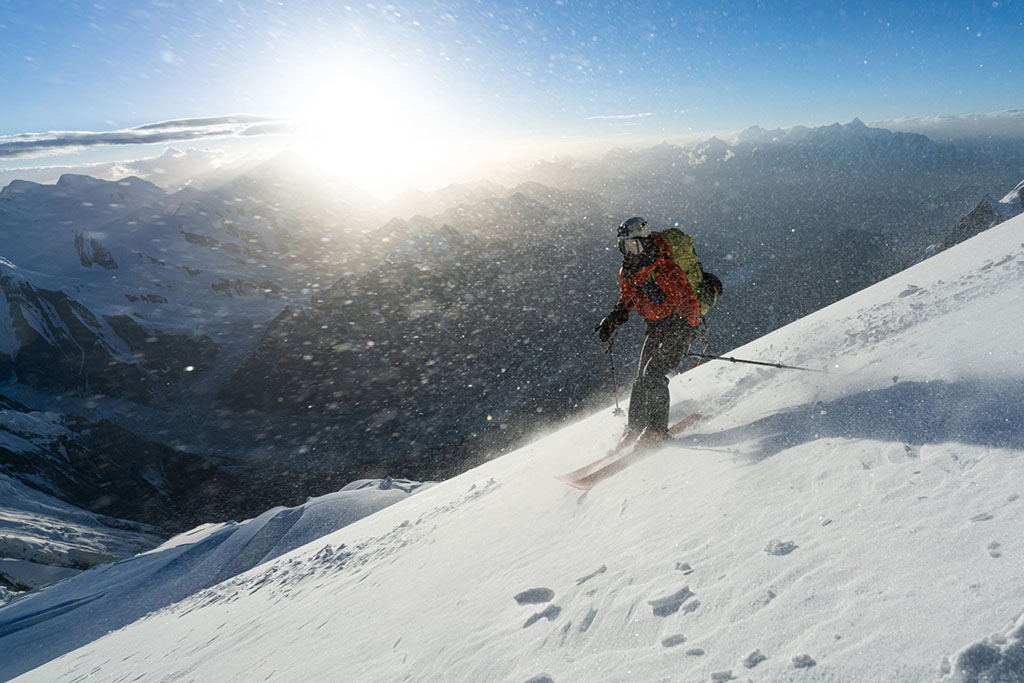
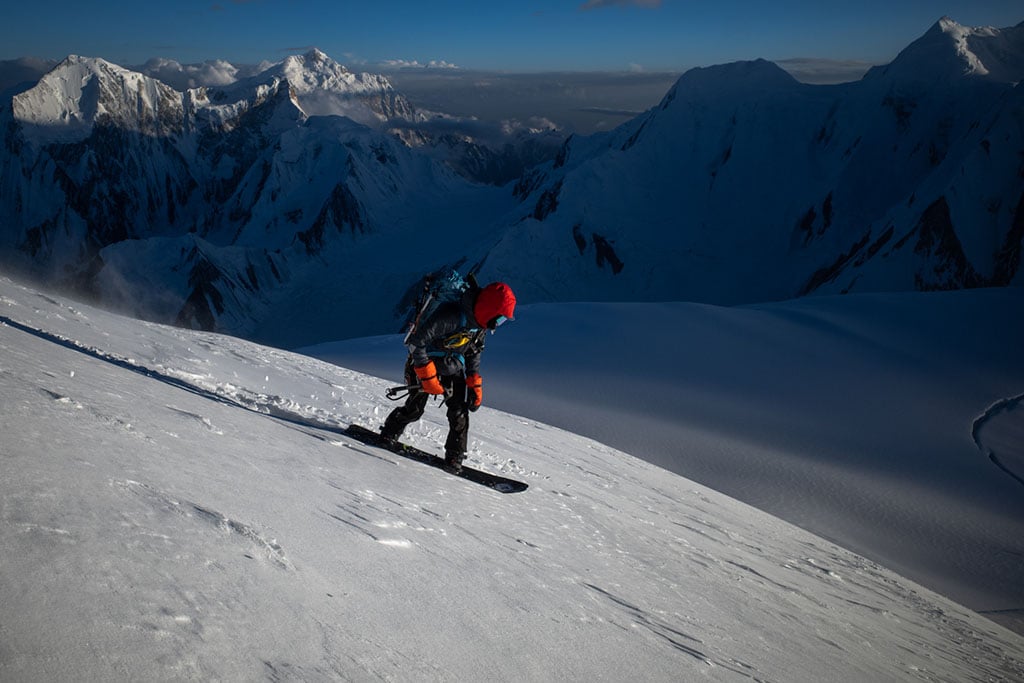
The next morning, we skied/split down to Camp 1, and then scrambled back to basecamp where we received a warm welcome from our Pakistani friends. As if on cue, the weather turned to garbage, shutting down other teams that had arrived at basecamp. It took five days to send word to and wait for our porters, and once again we began the trek back to Skardu. Despite being exhausted and a little homesick, our expedition was far from over. In Islamabad, developing COVID restrictions canceled multiple flights, some of them on the same day. After a layover in Paris, we managed to eventually escape and arrived back in the US, a few thousand dollars poorer thanks to excess baggage fees and same-day international flights.
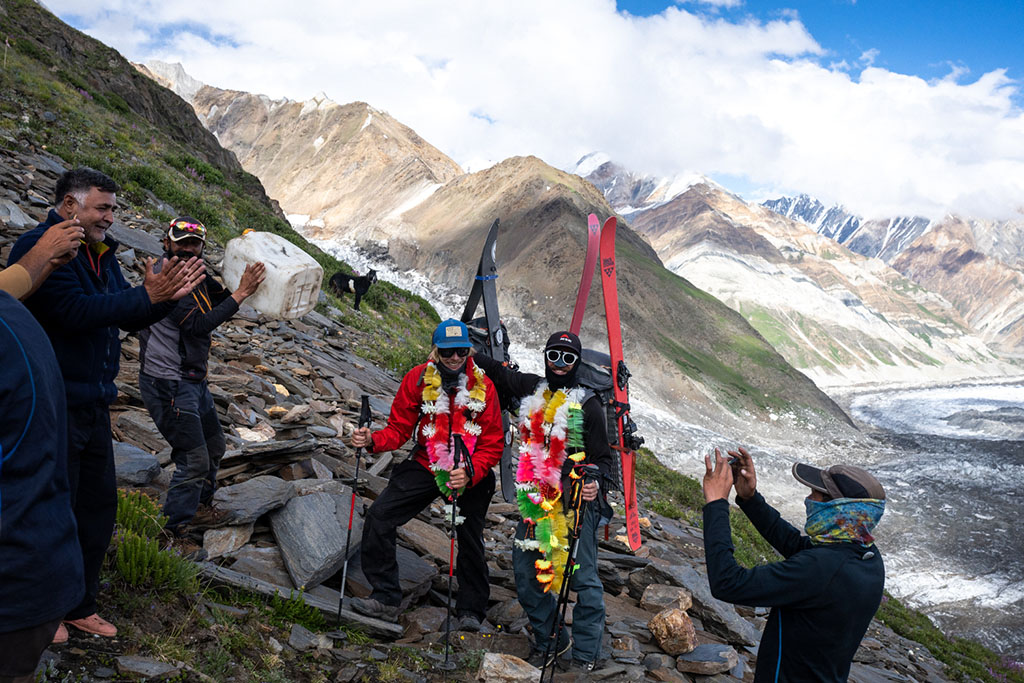
The highs and lows of back-to-back expeditions left us utterly exhausted but deeply satisfied. It had been a privilege to get our feet wet in the Karakoram and to be in the same places that so many of my heroes had gone to before. Until I return, I’ll be dreaming of when I do.
Related Posts:
- Winter Climbing: 9 Tips for Getting Started
- Exploratory Mountaineering
- Tips for Your First Alpine Climbing Trip
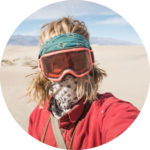 James Barkman
James Barkman
James is a photographer and alpinist who has a lot of trouble sitting still.

